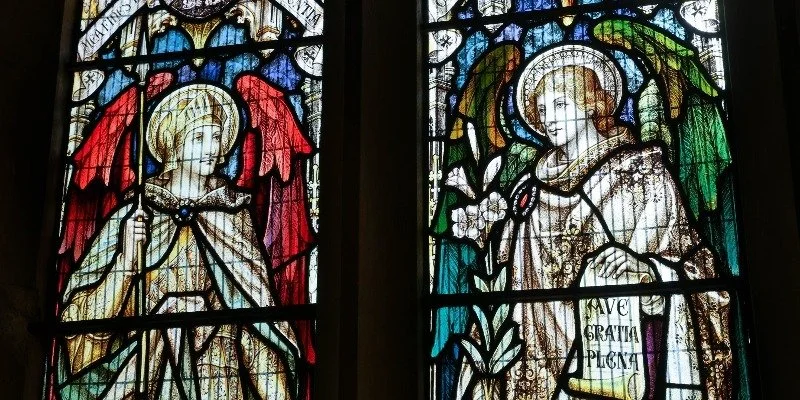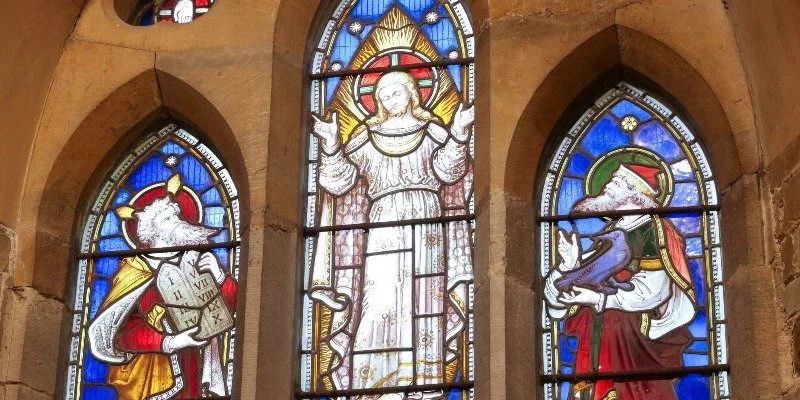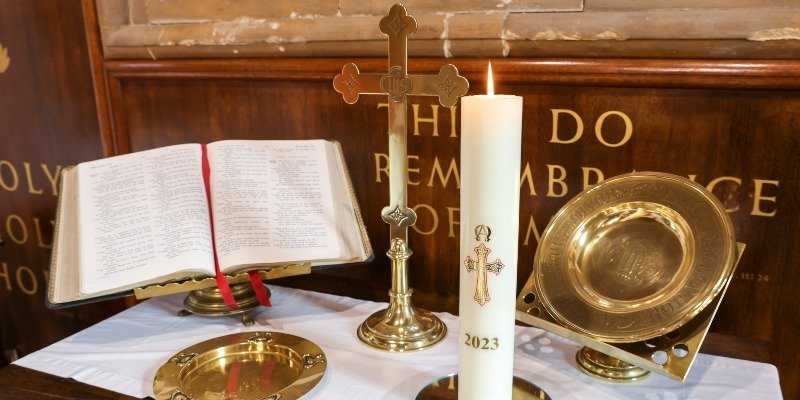heritage
St Andrew's Kinson is one of the ancient church sites of Bournemouth and Poole and, until c1830, served the area from the River Stour to the sea beyond Parkstone.
Up until 1868, it was a Chapel-of-Ease linked with Canford. It then became a Parish in its own right.
In 1952 an additional church, St Philip's, was built to serve the Southern end of the Parish. This was rebuilt in 1986.
In 1831, there were 775 persons in the Parish of Kinson, by 1891 this number had grown to 3650. Now there are over 20,000 residents living in the area served by St Andrew's and St Philip's who together form the Kinson & West Howe Team.
There may have been a church on this site in Saxon times (c950 A.D.) and some think the Tower which is the oldest part of the church is Norman (c1100). What is certain is the Tower and the Chancel Arch are both very old (12/1300 A.D.) and have survived several church rebuilding programmes.
The Chancel was rebuilt in 1875. The present body of the church was rebuilt in 1895, being made much larger than the previous one built in 1827.
The history of St Andrew's is one of a church changing to meet the needs of the times. This continues with several internal changes made to the church in 1982. The Lord's Table was then brought forward on an extended platform and the organ moved to a raised platform against the Tower.
Two memorial windows feature in the South Aisle:
The Isaac Fryer Memorial was erected by Ada Augusta Russell, in remembrance of her father - Isaac of Kinson who died 17th of April 1872.
This window features the angels Michael and Gabriel.
The inscription above Michael is translated "My faith is in wisdom".
As the one who visited Mary to announce that she would give birth to the long awaited Messiah, Gabriel also carries the scroll with the words Ave, Gratia, Plena, or Hail, Grace, Full - a reference to Luke 1: 28 "Hail, full of grace, the Lord is with you".
Towards the lower right of the window can be found the signed inscription confirming the work of A.L. Moore (Arthur Louis 1849-1939).
In the same aisle (east facing this time) can be seen the second dedicated window in the South Aisle.
This time in loving memory of Colonel Godfrey Russell, son of the Reverend John Russell, Rector of Landrinio and grandson of the late Dean of Battle.
This window was also erected by Ada Augusta Russell on the restoration of St Andrew's Church in 1892.
Jesus holds a brightly lit lantern with Isaiah on his left and John the Baptist on his right. John is depicted holding the inscription Ecce Angus Dei. "Behold the Lamb of God".
The work is again signed by A. L. Moore of 89 Southampton Row, London WC.
Situated in the Chancel, this centre piece is attributed to a company named Heaton, Butler & Bayne.
Though not signed, the fine features, hair and beards of Jesus and His disciples match closely with other identified works.
Jesus (top centre), Moses (top left) and Elijah (top right). The three disciples Jesus took with Him look on; Peter (centre bottom), James and John.
17-1800's: The Tower is used as a schoolroom.
1751: A Treble Bell was cast in Shaftesbury costing £13:8:2d plus carriage of 12s 0p
1797: Five of the original Tower's six bells are sold to a church in Bristol for £143:9s:4d with the proceeds being used to erect a Musicians Gallery above the Tower doors. This Gallery was later removed during the 1827 or 1895 rebuildings.
1827: The Chapel was enlarged as shown on the Chapel Enlargement Board which can be seen on the North wall of the North side aisles. This design, had a large transept going off to the North of the Nave. The Pulpit , Reading Desk and Lectern were in the middle of the present Chancel. Creed and The Lord's Prayer Boards, both painted on wood, hanging to the right of the Chancel Arch, also date from this time.
19th Century: A fire grate and internal flue (constructed from normal house bricks) were added across the inside South West corner of the Tower from ground level to give light and heat when the Tower was used as a Schoolroom. The internal flue was removed in 2005 when it was discovered to be unsafe. The bottom angle iron support was by then rusted away and the bricks were not keyed in to the surrounding stone walls!
1893-5: The present church was enlarged and rebuilt by adding side aisles as a cost of £1500. The church was then reopened by the Archdeacon of Dorset on the 31st of May 1895.
1904: The Tower Clock was added by Gillet & Johnstone, clockmakers of Croydon. It was installed in memory of Queen Victoria.
1909: The Western Tower wall was seriously cracked, this being repaired by under pinning and the insertion of wall ties.
1911: The present organ began life in 1911 and was dedicated in December of that year in remembrance of Augusta Russell who lived in Kinson House (now demolished). It was originally situated in the Vestry off the Chancel.
1920: The organ was moved to the North East corner of the Nave.
1982: The organ was refurbished and the keyboard console placed midway along the North wall. The organ pipes were moved to a newly constructed platform where the Minstrels Gallery used to be above the Tower's double doors.
2016: Extensive work commences in February to restore the church building. Works include a new heating system, electric wiring and lighting system, plastering, wooden flooring and pew cushions.
2022: The Tower Clock was refurbished and hourly chimes begin to ring out between 8am and 8pm every day.
2023: The inner entrance door was replaced with a new glass door which was installed on 15th November 2023. This work was made possible due to a legacy provided by former member of St Andrew's, Jeanne Webber. The door is etched with a fruit bearing vine design which was created by Miriam Wareham, who spent her childhood and youth as a member of the church community.
c 950 AD: In Anglo Saxon times, Kinson was already a small settlement. St Andrew's is built on an ancient site, but all traces of this era have vanished with the possible exception of the foundations at the base of the Tower.
c 1100: The Tower is the oldest part of the church and some think that it could date from 1100. The Tower was constructed of ironstone rubble with ironstone dressing. This brown textured stone was known in Dorset as Heath Stone. The flat headed Lancet Windows to the ground floor are deeply splayed one on each of the North and South walls.
On the right hand side of the Chancel Arch is a Mass Dial. This would have originally been placed outside the church and a wooden peg inserted in the hole. Carved markings radiating from the hole gave the time of the church services - the deeper cut marking 9 am Mass. This dial is one of the most ancient remains of a church built earlier than the Chancel Arch itself.
c 1200 to 1300: The octagonal lead lined font probably dates from this time (assuming there was no Saxon or Norman building here beforehand) and is made from Purbeck Marble. The Font rim bears the marks of hinges and straps to secure the cover as was the custom to prevent anyone stealing the Holy Water in local Witchcraft practices.
1500: One of the Glastonbury Chairs, in the Chancel, dates from 1500 and was removed from the Abbey at Glastonbury at the time of the Dissolution of the Monasteries under Henry VIII. It belonged to the monk Johannes. The other chairs were made in the 1930's.
1667: This is the date of the oldest Grave - situated in the Churchyard by the Tower.
c1670: The Royal Coat of Arms was hung in the church when Charles II reasserted the monarch's control over religious affairs in England after Cromwell's Commonwealth period. In 1760 restoration work was carried out on the painting by a Mr Taylor for the sum of £5. The Coat of Arms was moved to the North East corner of the church in 1982.
c 1700's: The Text Board on the South wall probably commemorates a rebuilding of the church at that time.
-
We believe it’s around 1000 years old!
-
Check out the Mass dial, which is around 900 years old! We’ve got some incredible history in the churchyard as well, perhaps see if you can find out something about Michael Trotman…
-
Sure - come and see us and ask - Or otherwise, why not check out Moonfleet of Kinson - Home









